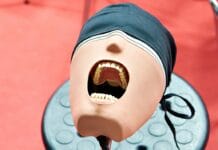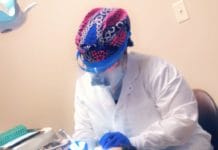Diving into my first job as a newly registered dental hygienist, I wasn’t sure what to expect. The dentist suggested it would be best for me to learn some dental assisting before jumping into treating hygiene patients on my own. I didn’t have any problem with starting my new job this way, and I thought it would be neat to step outside of my comfort zone to learn something new. Looking back on it now, I wouldn’t have wanted to begin my first job any other way because I can now say that I have a better understanding of what a typical day is like for a dentist and I can confidently explain common dental procedures to my patients when they have questions.
A typical day for me in the dental assistant role, started off with me showing up to work about 40-45 minutes before the first patient arrived.
I would set up the sterilization room, fill the ultrasonic machines, sterilize instruments, and stock up the dentist’s operatories for the day. Once those tasks were completed, I would check the schedule to see what materials would be needed for the first patient of the day. The patient would then arrive and it was my job to go over the basics with the patient, such as reviewing the medical history and taking vitals. Being a dental hygienist made it easier for me to understand the signs and symptoms some patients were feeling. It was also reassuring to me knowing most of the dental terms the dentist would call out to me.
In hygiene school, we learn about the work that dentists do and the types of restorative materials used to make such restorations. I remember specifically struggling with the entire concept of restorative dentistry because I am more of a visual learner. I like to see the steps taking place in front of me. After seeing and participating in some of the steps to repair tooth surfaces with the dentist, I was then able to look back on that one class, and everything finally started to become full circle.
Working as a dental assistant made the transition into hygiene mode extremely easy.
I was able to become familiar with the office, sharpen up on my Dentrix skills, and develop relationships better with my co-workers. It was helpful having a dentist that was willing to take the time to allow me to learn the ways of dental assisting. I was even given the opportunity to take radiographs when necessary. Taking radiographs was not my cup of tea in hygiene school. I absolutely dreaded taking them, but I can now say that I feel 99.9% better when taking images.
I truly wish I would have had the opportunity in hygiene school to interact and work with the dental students. I believe it is important for hygienists to know what it is that dentists actually do, step by step, on a daily basis by working with them during school. As hygienist’s we need to be knowledgeable about what it is that dentists are looking for. We should be asking our patients before we start their hygiene appointment if there is anything that has been bothering them dentally. If patients report that they have been feeling any discomfort or pain, we need to be asking them follow-up questions to gain a better understanding of how to proceed through the appointment. The dentist I work for will often give me the O.K. to go ahead and take a radiograph if I feel the dentist will need one, to save time.
Now that I am finally seeing patients of my own for hygiene appointments, there are still a handful of times that the dentist will ask me to help assist him if I have a patient cancel or a free block of time. I know the steps required to do a filling, crown prep, crown cementation, and more. Being in the dental hygienist role officially, I feel more well-rounded and slightly more qualified as a health professional. I encourage every hygienist to speak with their dental employers to gain a better understanding on the procedures they conduct and if possible, ask if you can observe or slide into being a dental assistant for a day or two. You never know what new pieces of information you will learn, and you may just make yourself that much more qualified as a dental hygienist.












